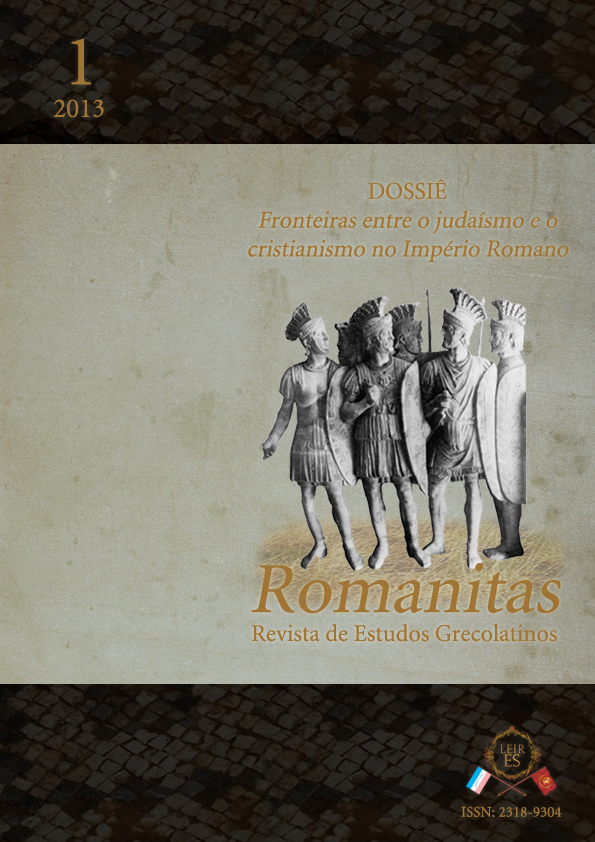Cyprian and the treatise De habitu uirginum: the construction of boundaries among the Christian virgins and the search for purity in the church of Carthage (third century AD)
DOI:
https://doi.org/10.17648/rom.v0i1.6390Keywords:
Cyprian, Carthage, Virgins, Boundaries, PurityAbstract
The treatise De habitu uirginum was written in 249 AD by Cyprian, bishop of Carthage between 249 and 258. This work presents the praises regarding the Christian virgins, treated as virtuous women, but also indicates the cautions and precautions they should take in relation to the temptations of the world, which may lead them to abandon the pudicitia considered, by the bishop, something sublime and essential to the functioning of the Christian community. Our purpose in this article is to analyze the admonitions and codes of conduct issued by Cyprian in relation to the Christian virgins – for example, the spaces of the city they could and could not attend, as well as how they should dress and behave – as a means of establishing the boundaries between the "true" virgin and preserving the purity within the community in Carthage.
Downloads
References
Documentação primária impressa
CIPRIANO DE CARTAGO. Cartas e Tratados. Introdução, versão e notas de Julio Campos. Madrid: BAC, 1964.
Obras de apoio
AUGÉ, M. Puro/Impuro. In: ROMANO, R. (dir.). Enciclopédia Einaudi. Lisboa: Imprensa Nacional-Casa da Moeda, 1994, p.55-73, v. 30.
ALEXANDRE, M. Do anúncio do Reino à Igreja: papéis, ministérios, poderes femininos. In: PERROT, M.; DUBY, G. (orgs.). História das mulheres no Ocidente – A Antiguidade. Porto: Afrontamento, 1990, p. 511-563. v. 1.
AUDOLLENT, A. Carthage romaine: 146 avant Jésus-Christ – 698 après Jésus-Christ. Thèse pour le doctorat. Faculté des letters, Université de Paris, 1901.
BOYARIN, D. Border lines: the partition of Judaeo-Christianity. Philadelphia: University of Pennsylvania Press, 2007.
BROWN, P. Corpo e sociedade: o homem, a mulher e a renúncia sexual no início do cristianismo. Rio de Janeiro: J. Zahar, 1990.
CAMPOS, J. Introdução. In: CIPRIANO DE CARTAGO. Cartas e Tratados. Madrid: BAC, 1964.
DEL PRIORE, M. História do cotidiano e a vida privada. In: CARDOSO, C. F.; VAINFAS, R. (orgs.). Domínios da história: ensaios de teoria e metodologia. Rio de Janeiro: Elsevier, 1997, p. 259-274.
DOUGLAS, M. Pureza e perigo. Lisboa: Edições 70, 1991.
FINLEY, M. As mulheres silenciosas de Roma In: ______. Aspectos da Antiguidade: descobertas e controvérsias. Rio de Janeiro: Edições 70, 1990, p.142-155.
GAUER, R. M. C. Da diferença perigosa ao perigo da igualdade: reflexões em torno do paradoxo moderno. Civitas, Porto Alegre, v. 5, n. 2, p. 399-413, 2005.
GÓMEZ, R. S. El corpus epistolar de Cipriano de Cartago (249-258): estructura, composición e cronología. Tese de doutorado. Programa doctorado: “Mediterránia: Prehistória i Món Antic, Departament de Prehistória, História Antiga i Arqueologia, Facultat de Geografia i História, Universitat de Barcelona, 2002.
GRIMAL, P. As cidades romanas. Lisboa: Edições 70, 2003.
GUARINELLO, N. L. História científica, história contemporânea e história cotidiana. Revista Brasileira de História, São Paulo, v. 24, n. 48, p. 13-38, 2004.
HELLER, A. O cotidiano e a história. São Paulo: Paz e Terra, 2008.
KRAEMER, R. S. Jewish women and women’s Judaism(s) at the beginning of Christianity. In: ______. Women & Christian origins. New York: Oxford University Press, 1999. p. 50-79.
MAHJOUBI, A. O período romano e pós-romano na África do norte. In: MOKHTAR, G. (coord.). História geral da África. São Paulo: Ática, 1985, p. 473-509.
PAGELS, E. Adão, Eva e a serpente. Rio de Janeiro: Rocco, 1992.
RIBEIRO JR., J. Pequena história das heresias. Campinas: Papirus, 1989.
SILVA, G. V. As mulheres e os perigos da cidade: casamento espiritual, virgindade e prostituição segundo João Crisóstomo. In: LEITE, L.; SILVA, G. V. da; CARVALHO, R. N. B.; FRANCALANCI, C. (orgs.). Figurações do masculino e do feminino na Antiguidade. Vitória: PPGL, p. 33-51, 2011.
SIQUEIRA, S. M. A. Instruir as mulheres: admoestação à modéstia do De cultu feminarum de Tertuliano. Acta Scientiarum, Maringá, v. 33, n. 2, 2011, p. 183-190.
______. Reflexões sobre política e igreja no século IV: um olhar para as mulheres cristãs. Dimensões, Vitória, v. 25, p. 148-163, 2010.
¬______. A mulher na visão de Tertuliano, Jerônimo e Agostinho – séc. II-V d. C. Tese de doutorado, Faculdade de Ciências e Letras de Assis, Universidade Estadual Paulista (Unesp), Assis, 2004.
______. A efervescência discursiva sobre as mulheres nos movimentos marginais do cristianismo primitivo e as respostas da patrística. In: FUNARI, P. P. A.; FEITOSA, L. C.; SILVA, G. J. da (orgs.). Amor, desejo e poder na Antiguidade: relações de gênero e representações do feminino. Campinas: UNICAMP, p. 375-390, 2003.
UBIÑA, J. F. El cristianismo greco-romano. In: SOTOMAYOR, M.; UBIÑA, J. F. (coords.). Historia del cristianismo: el Mundo Antiguo. Granada: Trotta, 2003, p. 227-292. t. 1.
WARD, R. B. Women in Roman baths. The Harvard Theological Review, v. 85, n. 2, p. 125-147, 1992.
Downloads
Published
How to Cite
Issue
Section
License
Copyright (c) 2014 Romanitas - Revista de Estudos Grecolatinos

This work is licensed under a Creative Commons Attribution-NonCommercial-NoDerivatives 4.0 International License.
a. The authors retain copyright and grant the journal the right to first publication.
b. The authors are authorized to assume additional contracts separately, for non-exclusive distribution of the version of the work published in this journal (e.g., publishing in institutional repository or as a book chapter), with acknowledgment of authorship and initial publication in this journal.
c. Authors are allowed and encouraged to publish and distribute their work online (e.g. in institutional repositories or on their personal page) after the first publication by the journal, with due credit.
d. The journal's texts are licensed under a CC BY 4.0 Deed Attribution 4.0 International Licence (CC BY).




























